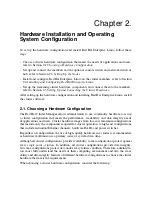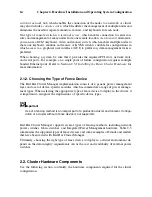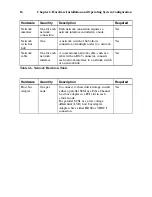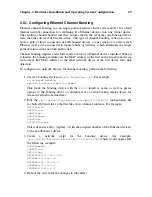
14
Chapter 2. Hardware Installation and Operating System Configuration
switch
or
network hub
, which enables the connection of the nodes to a network. A cluster
may also include a
console switch
, which facilitates the management of multiple nodes and
eliminates the need for separate monitors, mouses, and keyboards for each node.
One type of console switch is a
terminal server
, which enables connection to serial con-
soles and management of many nodes from one remote location. As a low-cost alternative,
you can use a
KVM
(keyboard, video, and mouse) switch, which enables multiple nodes to
share one keyboard, monitor, and mouse. A KVM switch is suitable for configurations in
which access to a graphical user interface (GUI) to perform system management tasks is
preferred.
When choosing a system, be sure that it provides the required PCI slots, network slots,
and serial ports. For example, a no single point of failure configuration requires multiple
bonded Ethernet ports. Refer to Section 2.3.1
Installing the Basic Cluster Hardware
for
more information.
2.1.2. Choosing the Type of Fence Device
The Red Hat Cluster Manager implementation consists of a generic power management
layer and a set of device-specific modules which accommodate a range of power manage-
ment types. When selecting the appropriate type of fence device to deploy in the cluster, it
is important to recognize the implications of specific device types.
Important
Use of a fencing method is an integral part of a production cluster environment. Configu-
ration of a cluster without a fence device is not supported.
Red Hat Cluster Manager supports several types of fencing methods, including network
power switches, fabric switches, and Integrated Power Management hardware. Table 2-5
summarizes the supported types of fence devices and some examples of brands and models
that have been tested with Red Hat Cluster Manager.
Ultimately, choosing the right type of fence device to deploy in a cluster environment de-
pends on the data integrity requirements versus the cost and availability of external power
switches.
2.2. Cluster Hardware Components
Use the following section to identify the hardware components required for the cluster
configuration.
Summary of Contents for Cluster Suite
Page 1: ...Red Hat Cluster Suite Configuring and Managing a Cluster ...
Page 5: ...Index 165 Colophon 171 ...
Page 6: ......
Page 14: ...viii Introduction ...
Page 16: ......
Page 24: ...8 Chapter 1 Red Hat Cluster Manager Overview ...
Page 92: ...76 Chapter 4 Cluster Administration ...
Page 98: ......
Page 130: ...114 Chapter 9 Setting Up a Red Hat Enterprise Linux LVS Cluster ...
Page 152: ...136 Chapter 10 Configuring the LVS Routers with Piranha Configuration Tool ...
Page 154: ......
Page 162: ...146 Appendix A Supplementary Hardware Information ...
Page 180: ...164 Appendix C Multipath usage txt File for Red Hat Enterprise Linux 4 Update 3 ...
Page 186: ......
















































